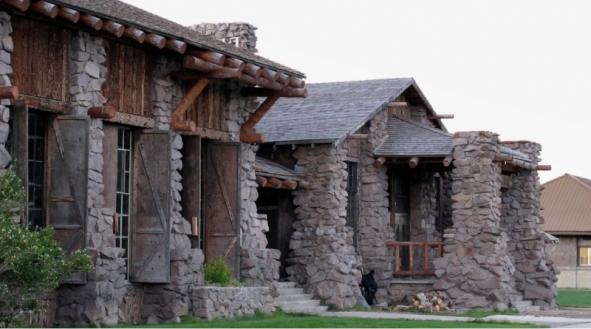The beautiful Yellowstone landscape is also wild country - one of the last and largest undeveloped regions in the continental United States. Yellowstone Park lies at the heart of this wild land and is home to many black bears and grizzly bears that roam through the country side they claim for their own.
Both black and grizzly bears are frequently encountered in and around Yellowstone Park, and both species are unpredictable. Since it can be difficult to tell the two species apart, hikers are best advised to be wary of all bears.
How do I identify a black bear versus a grizzly?
As a rule, black bears are generally smaller, less aggressive animals and most have black or dark brown hair. However, some black bears grow to be quite large and it is not uncommon to see cinnamon-colored "black" bears that closely resemble a grizzly bear. Adult grizzlies, on the other hand, are quite large with lighter-colored hair that is usually highlighted by silver tips, giving the animal a distinctive sheen.
Body Shape: The only true distinction between the two species is their body shape, the shape of their muzzles and their claws. Grizzlies have a hump above their front shoulders, making it the highest point in their body. On black bears the highest point is the rump. In a profile, the grizzly's face has a distinctive brow that gives the bear a dish-shaped muzzle. The black bear has a straight muzzle and the face appears round when viewed from the front.
Claws: Finally the grizzly bear has much larger claws Bears are found in the Yellowstone area. than black bears. Grizzly claws are several inches long and when the bear leaves a footprint, the claw impressions are about two to three inches in front of the pads.
Tips for Hiking or Camping in Bear Country:
There are no hard and fast rules to follow when a bear is encountered, because each encounter is different. But there are ways to avoid encounters.
Travel in Groups: Research shows there are less attacks when people travel in groups. Bears attack more frequently when one or two people are hiking, so groups of four or more are advisable and even required in certain parts of Yellowstone Park.
Hike during the Day: Hiking only during the daylight hours and making noise when approaching "blind curves" is another way to reduce the risk of encounters. One popular method to make noise is to whistle or sing while you walk. Most bears will avoid the encounter if they know a human is in the area.
Camping Tips: Special care should be taken when camping in grizzly country. All cooking should be done well away from the sleeping area and all food should be hung at least 10 feet up in trees away from the sleeping area, as should clothes worn while cooking and eating. Fish entrails should be thrown back into the water and burnable garbage should be placed in the fire or hung in a tree.
If you encounter a bear:
- Stay calm. It will probably leave you alone.
- Do not make abrupt moves or noises that would startle the bear.
- Give the bear plenty of room.
- Assume a non-threatening posture and turn sideways.
- Avoid eye contact.
- Slowly back away.
If a bear charges:
- Keep your pack on to provide protection.
- As a last resort, drop to the ground and assume a cannon ball position to protect head and stomach while playing dead.
- Don't move until you are certain the bear has left the area.
- REMEMBER: Running is likely to provoke an attack. Grizzlies' can attain short bursts of speed of up to 40 mph.










